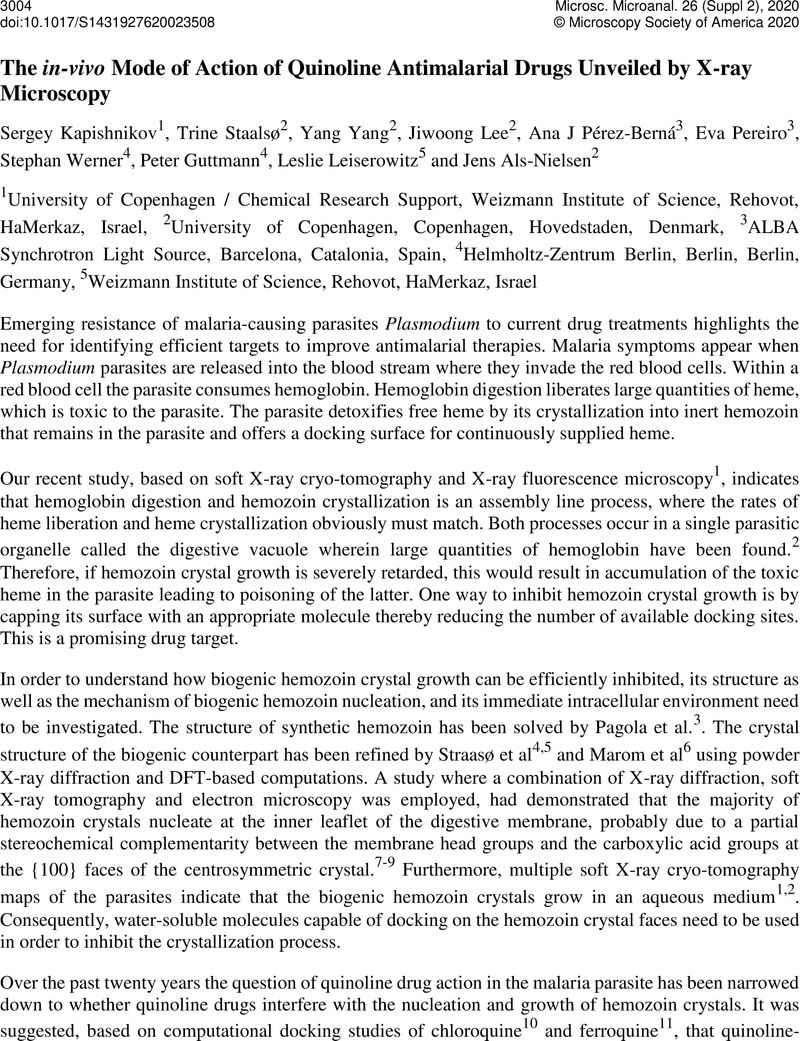No CrossRef data available.
Article contents
The in-vivo Mode of Action of Quinoline Antimalarial Drugs Unveiled by X-ray Microscopy
Published online by Cambridge University Press: 30 July 2020
Abstract
An abstract is not available for this content so a preview has been provided. As you have access to this content, a full PDF is available via the ‘Save PDF’ action button.

- Type
- Biological Soft X-Ray Tomography
- Information
- Copyright
- Copyright © Microscopy Society of America 2020
References
Kapishnikov, S. et al. Biochemistry of malaria parasite infected red blood cells by X-ray microscopy. Sci. Rep. 7, 802 (2017)10.1038/s41598-017-00921-2CrossRefGoogle ScholarPubMed
Kapishnikov, S. et al. Unraveling heme detoxification in the malaria parasite by in situ correlative X-ray fluorescence microscopy and soft X-ray tomography. Sci. Rep. 7, 7610 (2017)10.1038/s41598-017-06650-wCrossRefGoogle ScholarPubMed
Pagola, S. et al. The structure of malaria pigment β-haematin. Nature 404, 307 (2000)10.1038/35005132CrossRefGoogle ScholarPubMed
Straasø, T. et al. The Malaria Pigment Hemozoin Comprises at Most Four Different Isomer Units in Two Crystalline Models: Chiral as Based on a Biochemical Hypothesis or Centrosymmetric Made of Enantiomorphous Sectors. Cryst. Growth. Des. 14, 1543 (2014)10.1021/cg401151fCrossRefGoogle Scholar
Straasø, T. et al. The Role of the Four Stereoisomers of the Heme Fe-O Cyclic Dimer in the Crystalline Phase Behavior of Synthetic Hemozoin: Relevance to Native Hemozoin Crystallization. Cryst. Growth. Des. 11, 3342 (2011)10.1021/cg200410bCrossRefGoogle Scholar
Marom, N. et al. Structure and Formation of Synthetic Hemozoin: Insights From First-Principles Calculations. Cryst. Growth. Des. 11, 3332 (2011)10.1021/cg200409dCrossRefGoogle Scholar
Kapishnikov, S. et al. Digestive Vacuole Membrane in Plasmodium falciparum-Infected Erythrocytes: Relevance to Templated Nucleation of Hemozoin. Langmuir 29, 14595 (2013)10.1021/la402545cCrossRefGoogle ScholarPubMed
Kapishnikov, S. et al. Oriented nucleation of hemozoin at the digestive vacuole membrane in Plasmodium falciparum. PNAS 109, 11188 (2012)10.1073/pnas.1118120109CrossRefGoogle ScholarPubMed
Kapishnikov, S. et al. Aligned hemozoin crystals on a curved surface in malarial red blood cells revealed by nanoprobe X-ray Fe-fluorescence and diffraction. PNAS 109, 11184 (2012)10.1073/pnas.1118134109CrossRefGoogle Scholar
Buller, R. et al. Quinoline Binding Site on Malaria Pigment Crystal: A Rational Pathway for Antimalarial Drug Design. Cryst Growth Des 2, 553 (2002)10.1021/cg025550iCrossRefGoogle Scholar
Dubar, F. et al. The Antimalarial Ferroquine: Role of the Metal and Intramolecular Hydrogen Bond in Activity and Resistance. ACS Chem. Biol. 6, 275 (2011)10.1021/cb100322vCrossRefGoogle ScholarPubMed
Kapishnikov, S. et al. Mode of action of quinoline antimalarial drugs in red blood cells infected by Plasmodium falciparum revealed in vivo. PNAS 116, 22946 (2019)10.1073/pnas.1910123116CrossRefGoogle ScholarPubMed





